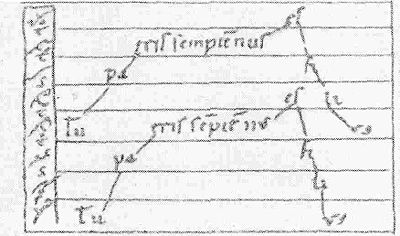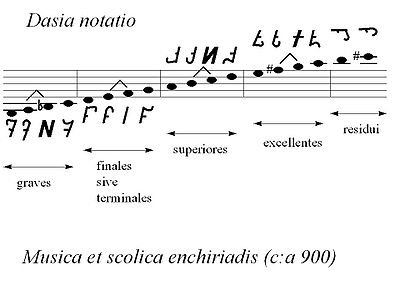
Daseian notation
Encyclopedia

Musical notation
Music notation or musical notation is any system that represents aurally perceived music, through the use of written symbols.-History:...
used in the ninth century anonymous
Anonymous work
Anonymous works are works, such as art or literature, that have an anonymous, undisclosed, or unknown creator or author. In the United States it is legally defined as "a work on the copies or phonorecords of which no natural person is identified as author."...
musical treatises Musica enchiriadis
Musica enchiriadis
Musica enchiriadis is an anonymous musical treatise from the 9th century. It is the first surviving attempt to establish a system of rules for polyphony in classical music. The treatise was once attributed to Hucbald, but this is no longer accepted. Some historians once attributed it to Odo of...
and Scolica enchiriadis
Scolica enchiriadis
Scolica enchiriadis is an anonymous ninth-century music theory treatise and commentary on its companion work, the Musica enchiriadis. These treatises were once attributed to Hucbald, but this is no longer accepted....
. The music of the Musica enchiriadis and Scolica enchiriadis, written in Daseian notation, are the earliest known examples of written polyphonic music in history.
Usage
Musicologist Willi ApelWilli Apel
Willi Apel was a German-American musicologist.Apel was born in Konitz, West Prussia. He studied mathematics from 1912 to 1914, and then again after World War I from 1918 to 1922, in various universities in Weimar Germany. Throughout his studies, he had an interest in music and taught piano lessons...
has called the notation "a mediaeval imitation of the ancient Greek notation". The treatises themselves refer to it as "dasia"; the word derives from the Greek
Greek language
Greek is an independent branch of the Indo-European family of languages. Native to the southern Balkans, it has the longest documented history of any Indo-European language, spanning 34 centuries of written records. Its writing system has been the Greek alphabet for the majority of its history;...
daseia, which refers to "rough breathing" at the start of a word in spoken prosody
Greek literature
Greek literature refers to writings composed in areas of Greek influence, typically though not necessarily in one of the Greek dialects, throughout the whole period in which the Greek-speaking people have existed.-Ancient Greek literature :...
.
Daseian notation makes use of a staff
Staff (music)
In standard Western musical notation, the staff, or stave, is a set of five horizontal lines and four spaces that each represent a different musical pitch—or, in the case of a percussion staff, different percussion instruments. Appropriate music symbols, depending upon the intended effect,...
of varying numbers of lines, from four to as many as eighteen, as well as a system of four shapes which are rotated in various ways to represent the full gamut of eighteen pitches used in the treatises. These eighteen pitches are based on a system of four repeating hexachords, resulting in the following scale:
Tritone
In classical music from Western culture, the tritone |tone]]) is traditionally defined as a musical interval composed of three whole tones. In a chromatic scale, each whole tone can be further divided into two semitones...
s, which were considered undesirable by theorists in performance and were probably mistakes of the author.
The notational signs were then placed at the far left of the staff (similar in placement to modern clef
Clef
A clef is a musical symbol used to indicate the pitch of written notes. Placed on one of the lines at the beginning of the staff, it indicates the name and pitch of the notes on that line. This line serves as a reference point by which the names of the notes on any other line or space of the staff...
), and some illustrations are supplemented with "T" and "S" in between the signs so as to clarify the placement of semitone
Semitone
A semitone, also called a half step or a half tone, is the smallest musical interval commonly used in Western tonal music, and it is considered the most dissonant when sounded harmonically....
s. Syllables of the spoken words were then written on the staff lines (see example above). If the pitch changed, the word syllables would be raised or lowered to a different staff line. This was used to notate organum
Organum
Organum is, in general, a plainchant melody with at least one added voice to enhance the harmony, developed in the Middle Ages. Depending on the mode and form of the chant, a supporting bass line may be sung on the same text, the melody may be followed in parallel motion , or a combination of...
in two, three and four-voice styles.
In addition to the Enchiriadis treatises, this notation is also used in the Commemoratio brevis de tonis et psalmis modulandis treatise. However, despite the wide circulation of the Enchiriadis treatises, this notation was not widely used in practical sources. Music manuscript
Music manuscript
Music manuscripts are handwritten sources of music. Generally speaking, they can be written on paper or parchment. If the manuscript contains the composer's handwriting it is called an autograph. Music manuscripts can contain musical notation as well as texts and images...
s of the ninth and tenth centuries record almost exclusively monophonic music, and even the extant sources of polyphonic music, such as the Winchester Troper
Winchester troper
The Winchester Troper includes perhaps the oldest large collections of two-part music in Europe, along with the Chartres Manuscript which is approximately contemporaneous or a little later. It consists of two English manuscripts dated circa 1000...
, are written in unheighted neume
Neume
A neume is the basic element of Western and Eastern systems of musical notation prior to the invention of five-line staff notation. The word is a Middle English corruption of the ultimately Ancient Greek word for breath ....
s. This would continue until the development of the widely used staff system of Guido of Arezzo
Guido of Arezzo
Guido of Arezzo or Guido Aretinus or Guido da Arezzo or Guido Monaco or Guido d'Arezzo was a music theorist of the Medieval era...
in the eleventh century.
Philipp Spitta
Philipp Spitta
Julius August Philipp Spitta was a German music historian and musicologist best known for his 1873 biography of Johann Sebastian Bach.-Biography:...
was the first modern musicologist to correctly interpret this notation, in an 1889 publication.


